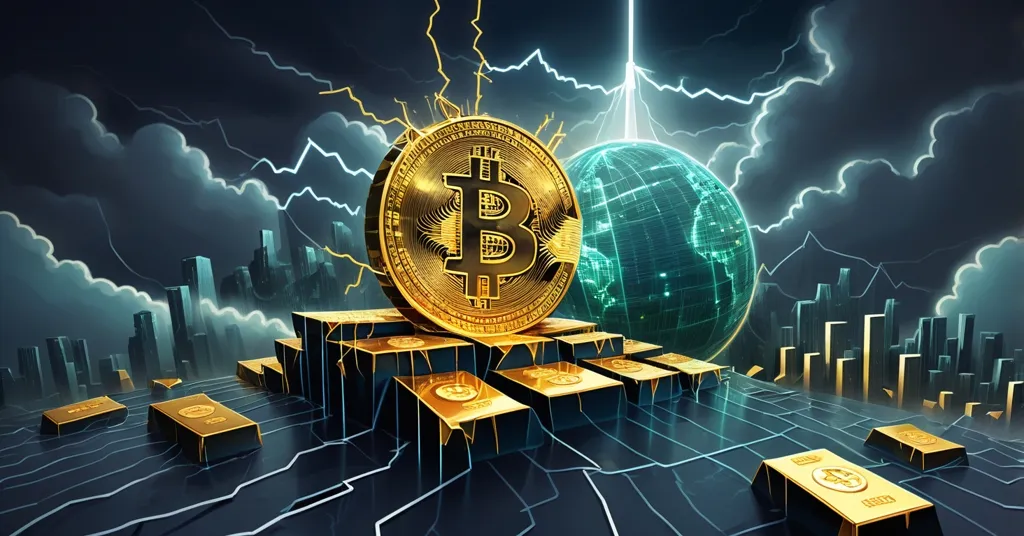RBA Warns of Global Risks: Could Bitcoin Be the Ultimate Hedge?

RBA Sounds the Alarm: Global Markets Blind to Geopolitical Risks—Is Bitcoin the Hedge We Need?
The Reserve Bank of Australia (RBA) has dropped a bombshell, warning that global financial markets are dangerously underestimating a brewing storm of geopolitical and macroeconomic risks. With financial fragmentation gaining steam and market complacency at an all-time high, the RBA’s top officials are sounding a wake-up call that could reverberate from traditional finance to the crypto world.
- Global Risks Ignored: Markets are failing to price in escalating geopolitical tensions and financial fragmentation.
- Gold as a Shield: Nations are stockpiling gold over fears of asset confiscation via sanctions.
- Crypto Implications: Could Bitcoin emerge as a digital hedge in this uncertain landscape?
RBA’s Stark Warning on Global Financial Fragmentation
Let’s cut to the chase: the RBA isn’t messing around with its latest assessment of global markets. Speaking at the Association of Superannuation Funds of Australia conference in Broadbeach, Queensland, Assistant Governor Brad Jones laid out a grim reality. He pointed to clear signs of financial fragmentation—a growing divide in global financial systems driven by geopolitical tensions and sanctions, creating isolated economic blocs that could disrupt trade and investment flows. One glaring example? A select group of nations is beefing up their gold reserves, not out of nostalgia for shiny metal, but as a direct response to fears of asset confiscation through sanctions. Think back to the 2022 Ukraine conflict, when sanctions on Russia froze billions in assets overnight. That’s the kind of risk pushing central banks to hoard gold as a safe haven against a polarized financial order.
Jones didn’t hold back on the market’s apparent cluelessness either. He flagged that risk premiums—the extra return investors demand for holding risky assets—across various asset classes have plummeted to “concerning lows.” Put simply, markets are acting like everything’s fine while ignoring the potential for sudden, catastrophic events, whether it’s a geopolitical flare-up or an economic shock that could wipe out portfolios faster than a flash crash on a crypto exchange. For more on this critical warning, see the RBA’s detailed concerns about global market risks.
“It’s not so much that we think the levels of risk premiums are completely unsustainable, we’re just surprised that there’s not a bit more reflected in those levels of spreads given what we observe, which is quite a confronting set of potential risks,” Jones stated.
In other words, investors are wearing blindfolds while juggling dynamite, and the RBA is baffled by the sheer audacity of this complacency. RBA Governor Michele Bullock, addressing the Australian Business Economists in Sydney on October 27, echoed this shock. She noted that she and her international peers are “flummoxed” by how “sanguine” markets remain, acting as if global tensions are just background noise. With a pointed jab, she asked:
“Could it all end up very badly?”
She didn’t spell out the answer, but the chill in the room likely spoke volumes. For Australia, an economy tethered to global trade and commodities, a sudden market nosedive or geopolitical misstep could hit like a freight train, impacting everyday folks through higher costs, job losses, or worse.
Inflation Headaches and Policy Tightropes
Switching gears to domestic challenges, the RBA is also sweating over inflation that just won’t quit. Their latest projections show inflation stubbornly sitting above the 2-3% target until at least mid-2026, with third-quarter figures clocking in at 2.6%, a tad hotter than the 2.5% midpoint they’d hoped for. Deputy Governor Andrew Hauser raised eyebrows by questioning whether the current cash rate of 3.6%—the benchmark interest rate influencing everything from mortgages to credit card debt—is restrictive enough to tame this beast. If you’re new to the term, a higher cash rate means pricier borrowing, which should slow spending and cool inflation, the pesky rise in prices for goods and services over time. But with demand still outpacing the economy’s potential and GDP growth last year marking the tightest recovery since the early 1980s, the RBA is stuck playing a high-stakes balancing game.
Bullock threw in another twist, clarifying that while asset prices don’t directly shape monetary policy, a brutal market crash affecting the broader economy could force their hand—potentially triggering rate cuts to juice up growth. Yet, she also noted the labor market remains “tight” despite unemployment ticking up to 4.5% in September. Tight means employers are still desperate for workers, pushing wages higher, which in turn keeps inflation simmering like a pot you forgot on the stove. It’s a messy situation, and the RBA knows one wrong move could tip everything into chaos.
Historical Echoes: When Complacency Bites
Let’s not pretend this is uncharted territory. History is littered with moments where markets shrugged off risks only to get sucker-punched. Take the lead-up to the 2008 financial crisis—low risk premiums and blind optimism fueled a housing bubble that burst spectacularly, dragging the global economy into the gutter. Even post-COVID, markets soared on cheap money while ignoring supply chain cracks and geopolitical flare-ups, only to face whiplash when inflation roared back. These aren’t just textbook lessons; they’re stark reminders that complacency can cost trillions. And here’s a kicker for crypto fans: during those same crises, Bitcoin often caught attention as an uncorrelated asset—its price spiked during the 2022 Ukraine mess as investors sought alternatives to fiat chaos. But it’s not all roses; Bitcoin also tanked hard during broader market panics like the 2020 COVID crash, proving it’s not immune to sentiment swings.
Bitcoin and Decentralization: Digital Gold in a Fragmented World?
Now, let’s talk about where this hits home for us in the crypto space. The RBA didn’t name-drop Bitcoin or blockchain, but their warnings scream relevance for decentralized finance. When nations stockpile gold over sanction fears, it’s not a huge leap to see why some investors might eye Bitcoin as the digital equivalent. Unlike gold, Bitcoin’s portable—you’re not lugging bars through customs—and it’s decentralized, free from any government’s whims (at least in theory). Its fixed supply of 21 million coins also makes it a potential hedge against fiat inflation, which the RBA admits could haunt Australia for years. During past geopolitical messes, like the 2022 Russia-Ukraine conflict, Bitcoin’s price often surged as trust in traditional systems wobbled. Could we see a repeat if the RBA’s feared fragmentation kicks into high gear?
Hold your horses, though—there’s a flip side, and it’s not pretty. Market complacency, as the RBA pointed out, infects crypto too. If traditional investors are ignoring risks, don’t bet on crypto traders being much wiser; meme coin mania and leveraged gambling show we’re not always the sharpest tools in the shed. Then there’s regulation. If governments start viewing Bitcoin as a sanctions-evasion tool—a real concern given past crackdowns like China’s mining ban or U.S. scrutiny of mixers—expect a hammer to drop. And let’s not forget volatility; Bitcoin might shine in a crisis, but it can also crater during risk-off periods, just as it did when markets bled in 2020. Compared to gold, it’s a wilder ride—less “safe haven,” more “rollercoaster with no seatbelt.”
Still, there’s a bigger picture here. Financial fragmentation and eroding trust in centralized systems could be the rocket fuel for decentralized tech, aligning with the idea of effective accelerationism—pushing innovation through disruption, even if it’s messy. Bitcoin might lead the charge, but let’s not sleep on Ethereum or other protocols building DeFi ecosystems that could redefine finance itself. If central banks are rattled, imagine an Aussie investor watching tensions rise—do they stick with shaky stocks or hedge with crypto? It’s a gamble either way, but decentralization offers a lifeline traditional systems can’t match. The catch? We’ve got to shake off our own complacency and navigate the regulatory minefield before these lifeboats are ready to sail.
Key Takeaways and Burning Questions
- What geopolitical risks is the RBA flagging for global markets?
They’re worried about escalating tensions, financial fragmentation, and sanctions leading to asset confiscation fears, all threatening market stability. - Why are nations hoarding gold, and does this hint at a crypto boost?
Gold is a hedge against sanctions and financial uncertainty; similar fears could drive interest in Bitcoin as a decentralized alternative if trust in fiat systems falters. - Are markets pricing in these risks adequately?
Not even close—risk premiums are at worrying lows, showing investors are blind to potential geopolitical and economic shocks. - How long will inflation plague Australia, and what’s the RBA’s plan?
Inflation will likely exceed the 2-3% target until mid-2026, with the RBA debating if the 3.6% cash rate is tough enough and considering cuts if markets collapse. - Could Bitcoin and DeFi be shields in this fragmented future?
Possibly—Bitcoin’s decentralization makes it a potential hedge, but complacency, volatility, and regulatory risks could undermine its role unless adoption accelerates. - How should crypto investors react to these warnings?
Stay sharp—diversify holdings, monitor geopolitical news, and brace for volatility, as both traditional and crypto markets could face turbulence.
The RBA’s alarm isn’t just a wake-up call for suits on Wall Street—it’s a glaring signal for anyone in the crypto game. As centralized systems creak under the weight of global risks, decentralized solutions like Bitcoin could be our shield, or at least a damn good plan B. But only if we play it smart, keep our skepticism dialed up, and push for adoption before the next crisis hits. Because if the RBA’s right, sitting on our hands isn’t an option—it’s a death sentence.



